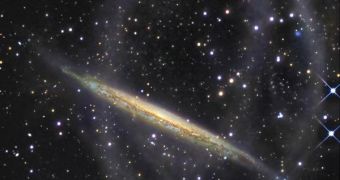The discovery of what appears to be yet another case of cosmic cannibalism between a massive galaxy and a dwarf one, similar to that between the Milky Way and the Sagittarius dwarf galaxy satellite, confirms the prediction of the cold dark matter model of cosmology, stating that large spiral galaxies formed through merges between less massive stellar systems. The evidence was found between two galaxies in the Local Group, presenting massive star streams in the outskirts of the galactic disk.
One of the two spiral galaxies is NGC 5907, located only 40 million light years away from Earth, is surrounded by material debris coming from a previous merging with a dwarf galaxy, about 4 billion years ago. Most of the mass of the dwarf galaxy has been lost in favor of the much larger NGC 5907, including stars, star clusters and dark matter, while the remnant debris was pushed in orbit around the spiral galaxy, some of which with orbital trajectories exceeding a radius of 150,000 light years.
"Our results provide a fresh insight into this spectacular phenomenon surrounding spiral galaxies and show that halos contain fossil dwarf galaxies, thus providing us with a unique opportunity to study the final stages in the assembly of galaxies like ours," said leader of the observation team, David Martines from the Instituto de Astrofisica de Canarias.
The fact that astronomers have failed so far to detect the main components of these dwarf galaxies led them to believe that they have been destroyed a long time ago. "These star streams are very difficult to detect and have a very low density of stars. It is this that gives them their ghostly aspect. Hence, being related with the death of a dwarf galaxy, they may be considered as the ghosts of now vanished galaxies," says Martinez.
The second of the two galaxies is NGC 4013, located 50 million light years away towards Ursa Major constellation. The field of debris surrounding it reaches distances up to 80,000 light years away from the galactic nucleus, mostly containing Population III stars. Similar rings of debris, as those found around NGC 5907, surround our galaxy, as a result of the destruction of a series of dwarf galaxy satellites, 3 billion years ago.
"Fitting theoretical models to these star streams enables us to reconstruct their history and describe one of the most mysterious and controversial components of galaxies: dark matter," argues theoretical astrophysicist at the University of Victoria, Jorge Penarrubia.

 14 DAY TRIAL //
14 DAY TRIAL //